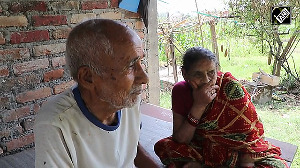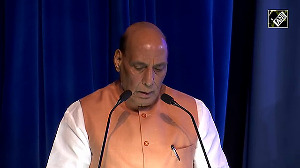As Hurricane Rita moved towards Texas and Louisiana, evacuation of thousands of people who left home for safer destinations became difficult with chaotic highways, dipping gas gauge and no food and water even as a bus carrying elderly people caught fire on a highway killing at least 24 along a major escape route.
More than 2 million people were leaving the Gulf Coast areas and Houston as the Category 4 hurricane barreled northwest across the Gulf with winds near 220 kph.
The 640 km-wide storm could also prove to be extremely dangerous to the numerious oil refineries in Texas.
Rita weakens to category 4 storm, millions flee Houston
The bus, filled with elderly passengers, that caught fire on the gridlocked Interstate 45 killing at least 24 passengers, caused a 17-mile backup on a freeway that was already heavily congested with evacuees from the Gulf Coast.
Thousands of people were trapped on the highways since Thursday, in a bumper-to-bumper mass exodus from the fourth largest city in the United States.
Buses carrying water and a possible evacuation method were dispatched to thousands of drivers stranded in traffic jams on the city most congested freeways, but fuel remained the most precious item for motorists, many of them who ran out of gas in 14-hour traffic jams.
Governor Rick Perry also ordered an unprecedented "contra-flow," opening 125 miles of the southbound lanes of Interstate 45 to northbound traffic, doubling the flow to eight lanes on the major evacuation route.
Texas is due to bear the brunt of the storm but forecasters said its path may shift east upping the risk that heavy rains may test New Orleans flood defences.
The storm weakened slightly as it swirled across the Gulf of Mexico, and forecasters said it could lose more steam by the time it comes ashore late Friday or early Saturday.
But it could still be an extremely dangerous hurricane -- one aimed straight at a section of coastline with the nation's biggest concentration of oil refineries. Officials said residents not in evacuation zones should no longer evacuate.
President George W Bush is due to visit Texas to oversee the preparations there.
The massive exodus of people overwhelmed the highway system, leaving expressways jammed like parking lots and the
Mayor said on radio that the clogged roads could be a death trap in a storm.
Motorists stuck in the jams were relieved to be told that the National Guard would be arriving with petrol supplies but when they came to begin emergency fuel distribution, it turned out that the nozzles on the tankers were too large for civilian automobiles.
Looking at the road conditions many people also changed their minds about leaving homes.
"We were planning to go to Austin, but the dipping gas is so discouraging and scarcity of it and food stuff made us to change our plans," an evacuee stuck on the highway said.
Buying water was also a problem. The water aisle at the downtown Randalls looks like Rita just hit it. Empty water boxes are thrown all over the floor and there is not one bottle of water left on the shelf.
Environmentalists warned of the possibility of a toxic spill from the 87 chemical plants and petroleum installations that represent more than one-fourth of US refining capacity. They also predicted a worst-case scenario in which a storm surge pushed spilled oil or chemicals from the bayous into the city of Houston itself, inundating mostly poor, Hispanic neighborhoods on its south side.
At Houston's Johnson Space Center, NASA evacuated its staff, powered down the computers at Mission Control and turned the international space station over to the Russian space agency.
Along the coast, petrochemical plants began shutting down and hundreds of workers were evacuated from off-shore oil
rigs.
Governor Perry said state officials had been in contact with plants that are "taking appropriate procedures to safeguard their facilities."
Rita also brought rain to already battered New Orleans, raising fears that the city's Katrina-damaged levees would fail and flood the city all over again. Most New Orleans Katrina victims are also relocating out of Houston.
"This is very traumatic for them. Many of them have lost everything," said Raynor.
In Galveston, a city rebuilt after an unnamed 1900 hurricane that killed between 6,000 and 12,000 residents in what is
still the deadliest natural disaster in US history, the once-bustling tourist island was all but abandoned, with at least 90 per cent off its 58,000 residents cleared out.
The city pinned its hopes on its 11-mile-long, 17-foot-high granite seawall to protect it from the storm surge, and a skeleton crew of police and firefighters to ward off potential looters.
"Whatever happens is going to happen and we are going to have a monumental task ahead of us once the storm passes," City Manager Steve LeBlanc said, adding, "Galveston is going to suffer and we are going to need to get it back in order as soon as possible."
In New Orleans, Rita's steady rains were the first measurable precipitation since Katrina. The forecast was for 3
to 5 inches in the coming days "dangerously close" to the amount engineers said could send floodwaters pouring back into neighborhoods that have been dry for less than a week.
"Right now, it's a wait-and-see and hope-for-the-best," said Mitch Frazier, a spokesman for the Army Corps of Engineers, which added sandbags to shore up levees and installed 60-foot sections of metal across some of the city's canals to protect against storm surges.
Katrina's death toll in Louisiana rose to 832, pushing the body count to at least 1,069 across the Gulf Coast. But workers under contract to the state to collect the bodies were taken off the streets of New Orleans because of the approaching storm.
In southwestern Louisiana, anywhere from 300,000 to 500,000 residents along the state's southwest coast were urged to evacuate and state officials planned to send in buses to take refugees, some of whom had already fled Katrina.
"Rita has Louisiana in her sights," Louisiana Gov Kathleen Blanco said, adding, "Head north. You cannot go east, you
cannot go west. If you know the local roads that go north, take those."
Also Read: How the Internet took on Katrina






 © 2025
© 2025